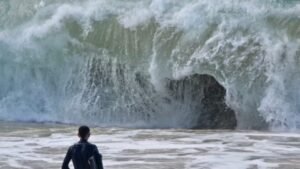Mega Tsunami Warning: Cascadia Subduction Zone Threat Looms Over U.S. West Coast
Recent scientific studies and seismic activity have heightened concerns about the potential for a mega-tsunami along the U.S. West Coast, particularly triggered by the Cascadia Subduction Zone (CSZ). This 600-mile fault, stretching from Northern California to Vancouver Island, poses a significant risk due to its history of powerful earthquakes and the potential for catastrophic tsunamis. This article provides updates on recent warnings, scientific findings, and recommended preparedness measures to mitigate the impact of such an event.
Recent Developments
A study published in the Proceedings of the National Academy of Sciences by Virginia Tech researchers, led by geoscientist Tina Dura, estimates a 15% chance of a magnitude 8.0 or greater earthquake occurring along the CSZ within the next 50 years. Such an event could trigger a mega-tsunami with waves reaching up to 1,000 feet, far exceeding typical tsunami wave heights of a few feet. This could devastate coastal areas in Washington, Oregon, and Northern California, with Alaska and Hawaii also at risk due to their own seismic vulnerabilities. The study highlights that a CSZ earthquake could cause coastal land to subside by up to 6.5 feet, expanding floodplains and leaving little time for evacuation.
In addition to these warnings, a magnitude 8.8 earthquake struck off Russia’s Kamchatka Peninsula on July 29, 2025, triggering tsunami alerts across the Pacific, including Hawaii, Alaska, and the U.S. West Coast. Waves up to 5.7 feet were recorded in Hawaii, and Crescent City, California, saw waves of 3.6 feet. While no major damage was reported, the event underscored the Pacific’s vulnerability to tsunamis and prompted evacuations and heightened alertness in multiple countries. By July 31, 2025, most tsunami warnings were downgraded or lifted, but the event served as a stark reminder of the region’s seismic risks.
Historical Context
The CSZ last produced a major earthquake in 1700, generating a tsunami that reached Japan. Historical events like the 1960 Chile earthquake, the 2004 Sumatra–Andaman earthquake, and the 2011 Tōhoku earthquake in Japan demonstrate the destructive potential of earthquake-induced subsidence and tsunamis. These events caused significant land loss, infrastructure damage, and forced relocations, offering lessons for CSZ preparedness. The Virginia Tech study notes that population growth and dense coastal development since 1700 would amplify the impact of a similar event today.
Current Risks and Impacts
The Virginia Tech study emphasizes that a CSZ mega-tsunami could inundate cities like Seattle, Portland, and coastal towns in Northern California within minutes. Computer models suggest floodplains could expand by up to 300 square kilometers, exposing over 170,000 buildings, 30,000 lives, and $81 billion in economic assets to risk. When combined with climate-driven sea-level rise, these impacts could intensify by 2100, potentially affecting an additional 22,500 structures and 1,250 kilometers of roads.
The recent Kamchatka earthquake, while not directly related to the CSZ, highlighted the immediate dangers of tsunamis. In Hawaii, evacuation orders caused gridlock, raising concerns about preparedness for a larger, closer event. In Russia, waves up to 6 meters flooded parts of Severo-Kurilsk, and the Klyuchevskaya Sopka volcano erupted, adding to regional instability.
Preparedness Recommendations
Experts urge coastal communities to enhance resilience through:
- Updated Evacuation Plans: Drills and clear evacuation routes are critical, as seen in the traffic congestion during the Kamchatka event. Communities should avoid over-evacuation and prioritize efficient movement to higher ground.
- Stronger Building Codes: Infrastructure must withstand both earthquakes and tsunamis, accounting for subsidence and flooding.
- Early-Warning Systems: The National Tsunami Warning Center provides real-time updates, and residents should have access to alerts via phones, sirens, and broadcasts.
- Community Preparedness: Families are encouraged to prepare “go bags” with essentials and establish reunification plans. Regular drills and awareness campaigns can reduce panic during emergencies.
- Long-Term Planning: Policymakers must integrate earthquake and tsunami risks with climate change projections to update flood zone maps and infrastructure designs.
Conclusion
The threat of a mega-tsunami from the Cascadia Subduction Zone remains a pressing concern, amplified by recent seismic events like the Kamchatka earthquake. While the immediate danger from the July 2025 event has subsided, the potential for a catastrophic CSZ event demands urgent action. Coastal communities must prioritize preparedness, infrastructure resilience, and public awareness to mitigate the human and economic toll of a future mega-tsunami. Staying informed through resources like the National Tsunami Warning Center (tsunami.gov) and local emergency management agencies is crucial for safety.














Post Comment